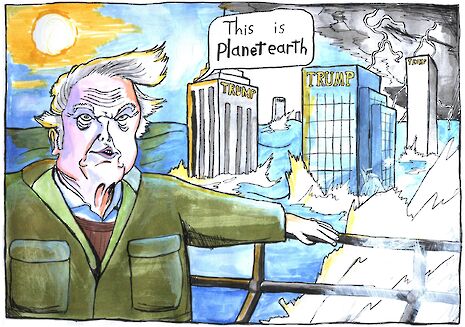Trump’s Planet Earth looks bleak but we must not give up hope
Trump affects all our futures: we must fight him

Earlier this December, US President-elect Donald Trump named Scott Pruitt as the head of the Environmental Protection Agency (EPA). Pruitt, the incumbent Attorney General for Oklahoma, is currently suing the EPA over the agency’s Clean Power Plan to reduce carbon emissions. Yes, you read that correctly – the person likely to run the EPA next year is also currently suing it, and has sued it numerous times in the past.
“Several of Trump’s other cabinet picks are also climate deniers, including a senator who called CO2 ‘a plant food’”
In addition to choosing Pruitt, a climate change denier who is vehemently opposed to almost any form of environmental regulation, to lead the agency dedicated to enforcing that environmental regulation, Trump is also on record as describing global warming as a “hoax” and has promised to scrap the Paris Agreement, the landmark international climate agreement adopted last year. Several of Trump’s other cabinet picks are also climate deniers, including a senator who called CO2 “a plant food”.
The outlook for environmentalists, therefore, is pretty bleak. The US is one of the world’s biggest carbon emitters, making up about a sixth of total global CO2 emissions, and its participation in international efforts to reduce global warming is vital if we are to stay below the crucial 2°C temperature rise which scientists say would have disastrous consequences. If Trump makes good on his promise to reverse the US’s recent shift towards clean energy, then dangerous climate change may become unavoidable.
Gloom and doom, it seems, is the forecast for the environment over the next four years. But Trump is not omnipotent, and although his climate policies are worrying, they might not be so easy to implement, and environmentalists have plenty of ways in which they can fight back. If, for example, Trump tries to rescind some of the EPA’s regulations, it wouldn’t be difficult for environmental groups like the Natural Resources Defense Council, who have the weight of scientific evidence behind them, to build a legal case against him. There’s also a historical precedent for their success – in previous administrations, cases brought against Bush’s EPA by environmental groups were frequently successful, whereas cases against Obama’s much greener EPA by fossil fuel industry groups were often unsuccessful.
Even if litigation doesn’t work, Trump will still run into all kinds of obstacles trying to roll back the current EPA’s regulatory agenda. To do the kind of 180-degree policy change that would be necessary, Trump’s EPA would need a legitimate and scientifically valid justification, especially for policies that have already been entrenched in EPA policy for some time. Such changes might even see pushback from industry – automobile manufacturers, for example, who, having completely modified their vehicle designs to fit the new standards, would have to change them all back again.
Another place that Trump might see resistance is in state governments. Because the US operates on a federal system, meaning the individual states have a lot of power over their own policies, states could easily ignore a new set of national environmental policies and simply continue their own stricter set of environmental regulations. Programs like the Regional Greenhouse Gas Initiative, a carbon trading program including nine states, have been successful in reducing CO2 emissions, and they’re likely to continue no matter who the president is.
If none of this works, perhaps a different line of argument is necessary, a language that the President-elect can understand – money. Over the past few years, a growing argument for a move towards clean energy is not just that it is better for the environment, but that it is a good business investment. Investment in clean energy currently stands at over $250 billion, double the amount of investment being put into fossil fuels, and, as the prices of renewables continue to fall, they become increasingly competitive. The momentum of this burgeoning new industry is unlikely to be stopped by Trump’s climate policies; even if he puts his weight behind industries like coal, national and international market forces demand are likely to make sure renewables keep growing.
“Even if all he does is drag his feet, that might be enough to tip us over the edge”
There is, of course, the possibility that none of this is enough. Climate change is an issue that keeps getting worse and worse, and urgent, rapid action is needed to mitigate its effects. Even if Trump is unable to implement all of his climate policies, even if all he does is drag his feet, that might be enough to tip us over the edge. Indeed, an article published in Nature earlier this year suggested that, even if all the countries who signed on to the Paris Agreement keep to their pledges, warming will still reach 2.6-3.1°C, well above the symbolic 2°C.
It’s a disheartening state of affairs, and it’s impossible to say whether or not the actions we take now will be enough. But I think it’s important to not lose hope. The only way to prevent the potentially devastating impacts of Trump’s climate policy is to fight back. If you’re a US citizen, vote for candidates who will support clean energy. If you’re not, support green politics in your home country. Join and campaign with environmentalist groups – there are many right here in Cambridge – and, if you can, donate to them. It’s now more important than ever that we fight for the future of our planet, and that, even in the face of a Trump presidency, we don’t give up hope
 News / Cambridge to have ‘England’s first official cycle street’7 October 2025
News / Cambridge to have ‘England’s first official cycle street’7 October 2025 Lifestyle / Which Cambridge tradition are you?6 October 2025
Lifestyle / Which Cambridge tradition are you?6 October 2025 News / Open letter calls on Newnham to divest from firms ‘complicit’ in Palestine9 October 2025
News / Open letter calls on Newnham to divest from firms ‘complicit’ in Palestine9 October 2025 Theatre / Macbeth makes a tragedy of the body itself9 October 2025
Theatre / Macbeth makes a tragedy of the body itself9 October 2025 News / Tompkins Table 2025: Trinity widens gap on Christ’s19 August 2025
News / Tompkins Table 2025: Trinity widens gap on Christ’s19 August 2025









